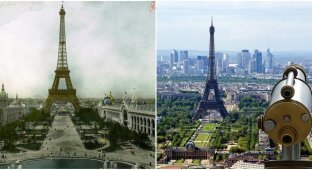Three guns against a hundred. Cheap and effective Martello towers (6 photos)
On February 7, 1794, two British ships approached the coast of Corsica, which supported revolutionary France. They were supposed to land troops to support the siege of San Florenzo (Siege of San Fiorenzo). However, in front of them there arose a fortification that was completely uncharacteristic of the 18th century, namely a round stone tower covering the fairway and armed with only two 18-pound cannons and one 6-pounder. 
Ruins of the Martello Tower on the coast of Corsica
The overwhelming superiority in artillery power - 74 guns on one ship and 32 on the other - brought nothing to the British. As a result of two and a half hours of battle, one of the ships was severely damaged and was forced to withdraw. The tower was also damaged, but did not lose its combat effectiveness at all. To overcome the fortification, the British had to land troops and attack the tower from the land side. They managed to take it only two days later, and to their great surprise it turned out that they were opposed by a garrison of only 33 people. Moreover, only two were mortally wounded during the assault. So unpleasant for the British was their acquaintance with the fortification called “Martello Tower”.
Coastal fortifications to protect against attacks from the sea have existed since time immemorial. After all, with the development of navigation and maritime trade, those who wanted to profit at the expense of others inevitably appeared. Pirates and the potential for an attack by neighboring states on a rich and prosperous city forced the authorities not to skimp on coastal fortifications.
In addition to the newly created fortifications, there was also a legacy of old times - coastal castles, the remains of majestic walls and towers. However, gunpowder and weapons based on it gradually neutralized the importance of coastal fortifications. The huge city could still be surrounded by thick stone walls that would hold back cannon fire. A competition began, known as the “fight between armor and shell” - the more artillery developed, the fortifications became more complex and expensive.
For that era, the existence of sailing battleships carrying hundreds of guns was no longer something out of the ordinary. Of course, they did not meet often, but even a pair of seriously armed sailing ships approaching the settlement could quickly turn it into a burning hell. And not every coastal city was insured against such a fate—it was too costly. 
Martello Tower on the coast of Ireland, converted into a residential building. 2007
The Martello Tower, first built in Corsica, represented a compromise. Relatively small, it also had a small number of guns. But because of its size, it could be built at key points along the coast, not only providing a firefight against those who would attempt to storm it, but also serving as a nearly invulnerable observation post. For example, residents of the coast of Corsica, where such towers were first built, paid the builders, as well as the garrison who served in them, a special tax and called it “Torreggiani”. An early prototype of the tower, intended to defend against pirate raids, was designed and built by the Genoese. Much later, when the threat of pirates subsided, but still did not disappear completely, the towers were rebuilt and converted into what the British later came across. 
Martello Tower off the coast of Ireland. Shenique Island, County Dublin, 2018
After that battle, the English naval commanders were extremely impressed by the simplicity of the design and the effectiveness of the towers. So much so that, according to their recommendations, the towers were copied and built in large numbers on the coast of England, which feared an amphibious assault from France, where Napoleon Bonaparte had just come to power.
Between 1804 and 1812, approximately 103 Martello towers were built on the south and east coast of England. Over all the years of use, they have never been able to repel fleet attacks, although this is precisely what they were originally intended for. However, the towers proved extremely effective as observation posts to counter smuggling. Their design was so successful that Great Britain built such fortifications in almost all of its colonies. Towers were erected in Australia, Canada, off the coast of India, Malta, Indonesia, South Africa and North America. 
Map of the location of the Martello Towers
The height of the tower reached 12-15 meters, and in two or three floorsThere were from 15 to 30 garrison people. Particularly thick stonework and relatively small dimensions made the tower very resistant to fire from naval guns. 2-3 guns were usually installed on the top, and with the help of a rail system they could be very quickly deployed in the desired direction, which gave good accuracy and density of fire in a certain sector. The entrances to the tower were usually located at a height of 2-3 meters, and it was possible to get inside only through a narrow staircase, which was often made removable and hidden inside at the slightest threat.
The importance of Martello towers as fortifications declined significantly with the advent of rifled artillery. It turned out that such guns were excellent at destroying even the thick masonry of the tower. Undoubtedly, for some time it could serve as a shelter and firing point, but it lost its value as a low-vulnerability fortification. By the beginning of the Crimean War and the massive use of rifled artillery, such towers had finally lost their significance. Subsequently, many of them were dismantled or destroyed in various conflicts, or even simply destroyed during testing of new weapons. Already during the Second World War, some surviving towers became an excellent platform for placing anti-aircraft artillery on them. At the moment, the few surviving Martello towers are mostly historical monuments. 
Prince of Wales Tower. The oldest Martello Tower in North America, built in 1796
It is worth saying that the Martello towers turned out to be an excellent fortification for their era. The combination of good security, comparative cheapness and speed of construction (compared to large fortresses) made them extremely popular among colonial powers. With the rapid development of weapons technology, these fortifications quickly became outdated and became ineffective against new types of weapons.

























